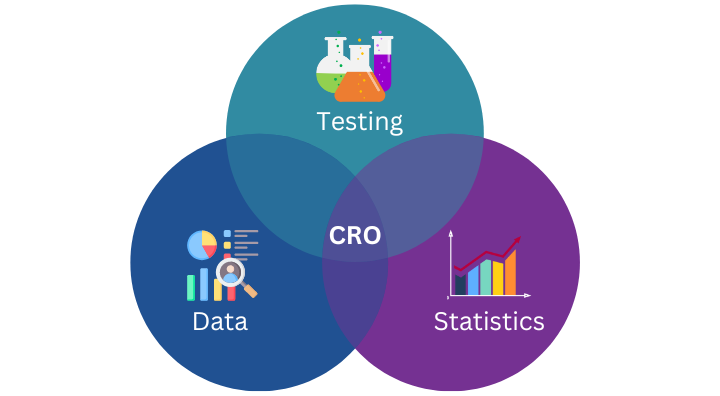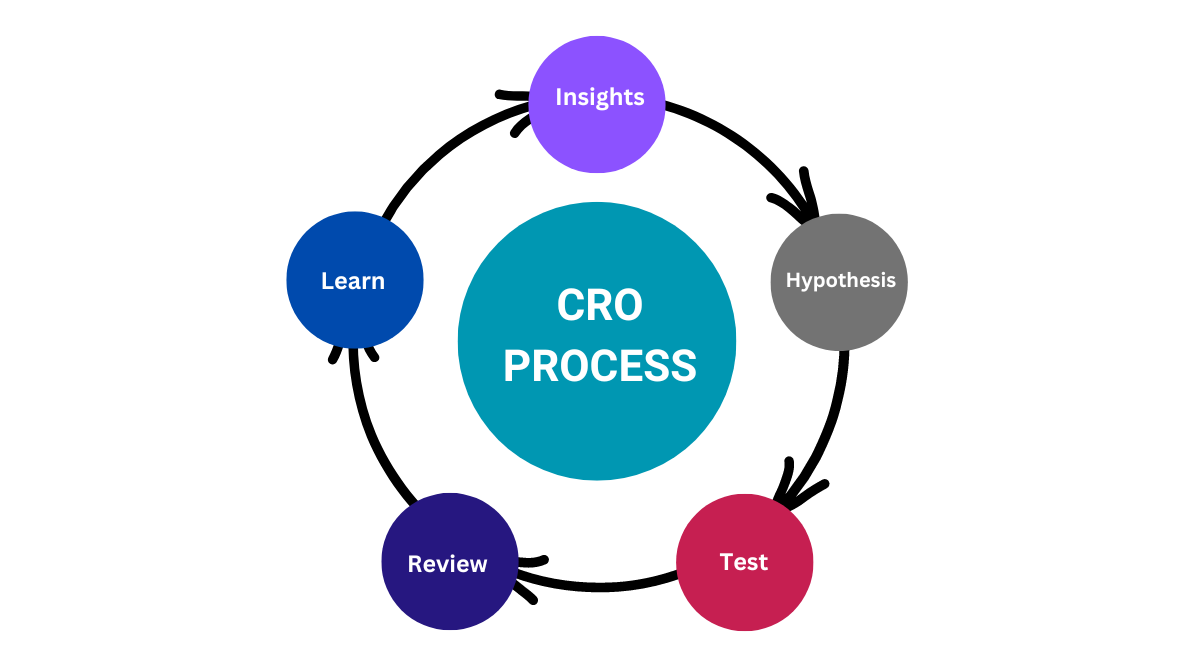Conversion rate optimization (CRO) is a vital marketing strategy that aims to increase the number of sales on a website by measuring visitor behavior and making changes to the website to improve its key performance metrics. In this beginner-friendly guide, I will break down the basics of CRO and help you answer the following questions:
- What is CRO?
- What are the CRO basics?
- What are the skills involved in CRO?
What is CRO?
CRO is the process of making a user take a specific action in response to a call-to-action on a website. This action could be anything from buying a product or subscribing to an email list to booking a sales call. and We do that by measuring how visitors behave and making some changes to the website to increase its key performance metrics.
To understand the terminology let’s start by dissecting the keyword CRO:
- Conversion: it’s the process of making a user take a chosen action in response to a call-to-action on a website. It could be simply buying a product, subscribing to an email list, booking a sales call, or other desired actions.
- Rate: The rate is calculated as follows
Visitors / converted visitors = Conversion rate
So let’s say 100 people visit your website and 2 of them convert, for example, they buy your product, then your conversion rate is 2%. Many business owners neglect this aspect and focus only on the ROAS (Return On Ad Spent) instead of also looking at the conversion rate of their website. - Optimization: So to optimize something we have to make some changes to our website and remove the elements that dissuade people from converting like bad use expererience or sales copy that doesn’t persuade the visitors and replacing them with elements that encourage conversion.
But how can we determine these elements? Some of your changes will result in an increase the performance some won’t, we need a data-based process to determine which ones we want to keep. This is exactly what CRO is about, it’s playing the role of a scientist that is trying to gather evidence to prove or disproof that an element affects the conversion rate and keep only the ones that are increasing it and we do that based on 3 principles: Data analysis, Scientific method, and Statistics.

Of course, CRO involves many other disciplines like psychology or UX but the 3 above are the main ones. Let’s start by explaining each one of the 3 principles and how you can leverage them to be successful in your optimization:
CRO basics
🔎 Data Analysis
It’s the starting point of every CRO workflow, we first go through data and find insights about what we need to change. Data is basically a generator of conversion barriers there are 2 types of data, from which we can take ideas to test.
Quantitative data such as:
- User analytics
- User Intelligence (heatmaps, session recordings, and scroll maps)
- Surveys
And qualitative data from:
- Focus groups
- User Testing
- Buyers' personas
Looking at analytics is a strong indicator of things to change on your website compared to just trying to mimic best practices since each business can be in a different industry and have different customers.
From these analytics, we gather insights which are a list of testing ideas (more on that shortly) that we then prioritize using, for example, the ICE framework by evaluating the ones that have the biggest Impact, the highest chance of success if implemented (Confidence) and the one with the least Effort of execution.
🔬Scientific method
When we are trying to establish some facts, we are victims of our biases, our opinions are mostly subjective and are based on our experience. To go over these limitations we created the scientific method a reliable process to establish facts. Once we gathered our insights the second step of the process is to use them to build a hypothesis, here is how to write one:
If I ______
I expect _________
As measured by ________
For example, we notice that the number of clicks on a certain page is low, here is a test hypothesis to solve that:
If I move the call-to-action button to the top of the page,
I expect that more visitors will click on it,
As measured by the number of click events.
This looks promising already, but we have to remember this is just a hypothesis and we still need to put it to the test before we come to any conclusion. In CRO we use A/B testing to put our hypothesis to the test.
A/B testing or also called split testing is presenting to a group of your visitors a different version of your website, and to another group the original version. Then we can see which version performed best (the one that drives the most leads or the most sales), of course, we need to make sure that the variant version has only one element change at a time, to know exactly what caused the change in the performance.
Our tests need a statistically significant sample, leading to our next principle.
📊Statistics
Statistics plays a crucial role in the CRO process, we use them every single day in our daily life. Let’s say you went Shopping on your favorite e-commerce website and now need to decide between two products.
Product A: 5/5 Stars (2 reviews)
Product B: 4.7/5 Stars (250 reviews)
You are not going to choose the 5-star reviews right? Because product B is very close to the rating of product A and has way more reviews, meaning that it’s more statistically significant, statistics help us make data-based decisions without any bias.
To get back to our hypothesis testing, we can’t come to a conclusion unless we have a significant sample to get reliable results that are not only valid for the sample but also help us predict results for future visitors.
So to sum up the CRO process:

What are the other skills involved in CRO?
Now that we have a better understanding of the CRO process, let’s talk about the skills involved, you typically find a team with each person having one specialized skill.
-
Statistics: Understanding them is quite hard since it involves doing some calculations to find if the sample size was sufficient, there are of course tools to help us determine the sample size but they require some foundation knowledge.
-
Psychology: Getting into your customer’s mind is the goal of every marketer, it will help us adapt our message and website from the customer’s perspective instead of ours.
-
Copywriting: It consists of writing texts aiming to increase brand awareness or to persuade a person, so changing a headline for example could be a split test on its own.
-
UX/UI: Improving a website’s interface and usability is one of the main goals of CRO, improve the usability of a website will definitely result in people using your product more frequently and thus increasing your KPIs.
-
Web development: Testing new things means interacting with websites whether it’s hiding or adding a new element, so a basic understanding of HTML CSS, and JS is required to run split tests.
Conclusion
I hope you have a better understanding of what CRO is now, it’s a complicated process without doubt it takes from many disciplines and oftentimes requires a team of people. But the investment is well worth it, according to wordstream CRO tools have an average ROI of 223%, so implementing CRO into your online business will most likely result in long-term profit.